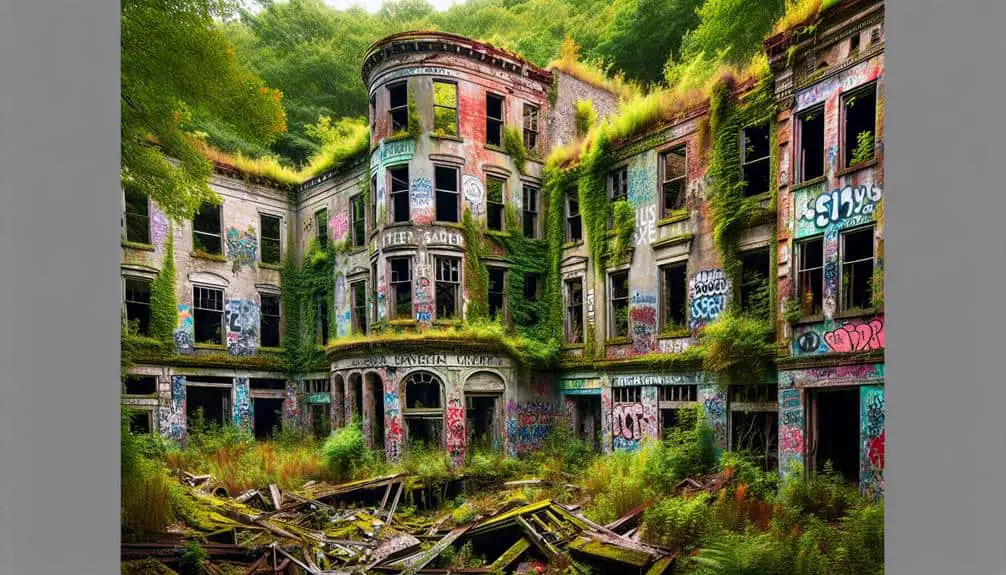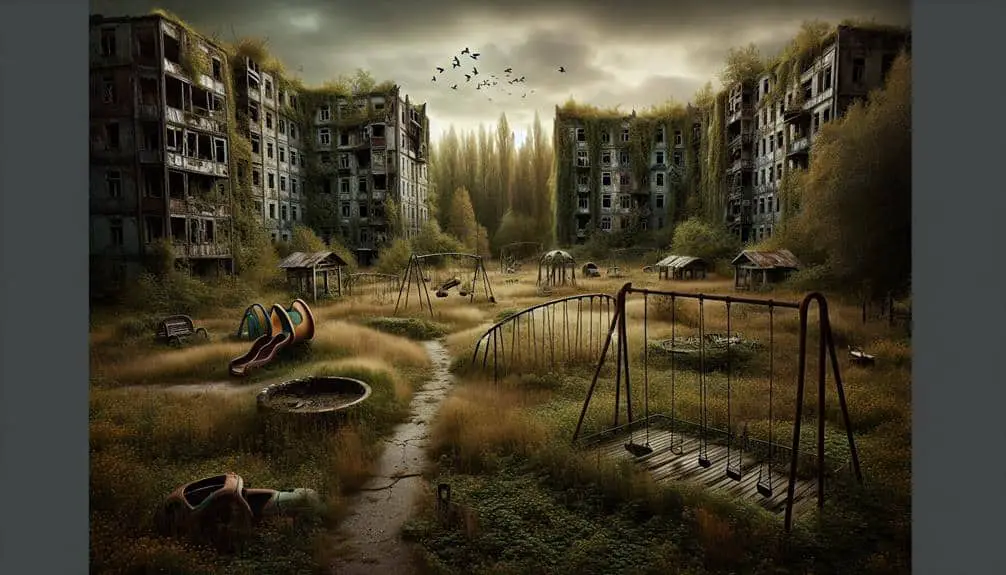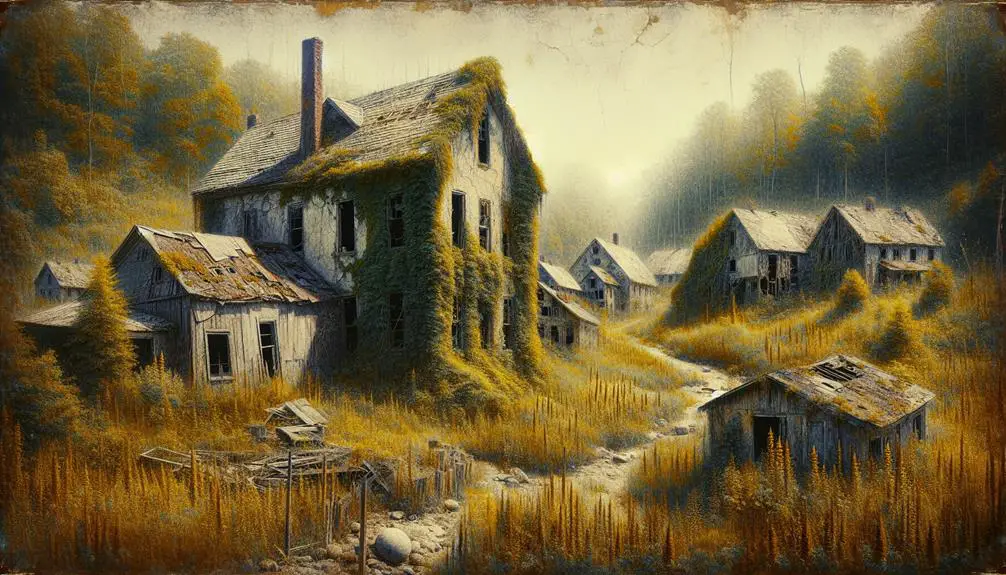Explore abandoned utopian communities in the US for a window into communal living experiments. New Harmony, birthed in 1814, sought utopia through shared resources but faced internal discord. Witness the legacy of the Shakers in their equality beliefs and furniture craftsmanship. Amana's deserted streets mirror a bygone era of German influence and detailed architecture. Discover the Oneida Community's preserved artifacts and architectural style hinting at past social structures. Brook Farm's ruins offer a glimpse of aspirations for simplicity and equality intertwined with nature. Unravel these tales of forgotten utopian dreams, revealing alluring narratives of America's communal past.
Key Points
- Explore New Harmony's communal living remnants with insights into its rise and fall.
- Discover the unique architectural legacy of the Shakers, known for their furniture design.
- Wander through Amana's deserted streets reflecting German influences and meticulous attention to detail.
- Uncover artifacts and preserved architecture of the Oneida Community, offering insights into communal living.
- Delve into Brook Farm's ruins, witnessing a utopian experiment's remnants intertwined with nature.
Rise and Fall of New Harmony
New Harmony, once a beacon of communal living experimentation in the early 19th century, ultimately succumbed to internal strife and financial instability, leading to its inevitable decline. Founded by German immigrant George Rapp in 1814, this town in Indiana aimed to create a utopian society based on communal living principles. Rapp's religious beliefs heavily influenced New Harmony, with residents sharing property and resources in pursuit of a harmonious community.
Societal experiments within New Harmony included innovative educational systems and communal dining. However, differing ideologies among residents created tensions, challenging the community's unity. Financial struggles further exacerbated the situation, causing the grand vision to crumble.
Despite its demise, New Harmony's legacy endures as a reminder of the complexities involved in communal living experiments. The rise and fall of New Harmony serve as a proof to the challenges faced when attempting to establish utopian societies. Through understanding the history of such endeavors, we gain insights into the delicate balance required for communal living to thrive.
Uncovering the Shakers Legacy
The Shakers' legacy reveals a fascinating history of communal living practices and cultural contributions in the United States. The Shakers were a religious sect that believed in simplicity, equality, and communal living. Their influence can still be seen today in various aspects of American culture and society.
Here are four key points to ponder regarding the Shakers' influence and the communal living revival:
- Architectural Innovation: The Shakers were known for their unique style of architecture, characterized by simple and functional designs. Their buildings often featured clean lines, handcrafted details, and efficient use of space.
- Furniture Design: The Shakers were skilled craftsmen who produced high-quality furniture known for its simplicity, durability, and elegance. Many of their designs have influenced modern furniture makers and designers.
- Social Equality: The Shakers' commitment to gender and racial equality was ahead of its time. They believed in the equal rights of all members, regardless of background or gender.
- Cultural Contributions: The Shakers made significant contributions to American music, dance, and craftsmanship. Their legacy continues to inspire artists and creators today.
Exploring Amanas Empty Streets
Walking through Amana's deserted streets reveals a haunting emptiness that echoes the community's past vibrancy. The Amana Colonies, once bustling with activity and purpose, now stand as a stark reminder of forgotten utopian ideals. The architecture in Amana reflects a blend of German influences, with sturdy brick buildings and well-maintained facades that speak to the community's commitment to craftsmanship and communal living.
As you wander through the empty streets, you can't help but notice the meticulous attention to detail in every building. The simplicity of design is juxtaposed with the grandeur of the structures, creating a unique atmosphere that's both serene and thought-provoking. Each building tells a story of a bygone era, where collective living and self-sufficiency were paramount values.
Despite the emptiness that now pervades the streets, the spirit of Amana's past residents lingers in the air, a reminder of a time when utopian dreams were within reach. As you explore the deserted pathways, you can't help but feel a sense of reverence for the visionaries who once called this place home.
Remnants of the Oneida Community
Amidst the remnants of the Oneida Community, echoes of communal living's intricate social structure can still be discerned. The historical site offers a glimpse into the once-thriving community that practiced complex marriage arrangements and shared property. Exploring the preserved buildings and artifacts provides a window into the communal living traditions of the past.
Markdown List:
- Preserved Architecture: The well-maintained buildings showcase the unique architectural style of the Oneida Community, reflecting their emphasis on functionality and communal living spaces.
- Oneida Artifacts: Various artifacts like communal dining utensils, shared living spaces, and religious symbols offer insights into the daily lives and beliefs of the community members.
- Social Structures: The layout of the community's buildings and common areas hints at the social dynamics and organizational hierarchies that governed daily life within the Oneida Community.
- Community Practices: Interpretive signs and guided tours provide context on the community's beliefs, practices, and the ways in which they sought to create a utopian society through communal living.
Visiting the remnants of the Oneida Community allows you to explore a fascinating chapter of American history and witness firsthand the relics of a once-vibrant experiment in communal living.
Delving Into Brook Farms Ruins
Exploring the ruins of Brook Farm reveals a glimpse into another utopian experiment in communal living in the US, showcasing the remnants of a community that once endeavored for a harmonious coexistence. As you wander through the overgrown paths and crumbling structures, you can immerse yourself in the history of this 19th-century transcendentalist community. Nature has begun to reclaim the land, intertwining with the historical artifacts scattered throughout the site.
The rusted farming equipment and dilapidated buildings stand as a proof to the aspirations of those who sought a simpler way of life. The serene atmosphere of the farm invites you to reflect on the idealistic vision that once thrived here. Walking through the remains, you can almost hear echoes of discussions on equality, education, and communal cooperation that once filled the air.
Amidst the decaying structures, the beauty of nature persists, offering a tranquil backdrop to contemplate the rise and fall of Brook Farm. Each step you take uncovers layers of history, inviting you to dig deeper into the complexities of utopian dreams and the realities they faced.
Frequently Asked Questions
Are There Any Paranormal Experiences Reported by Visitors Exploring These Abandoned Utopian Community Remnants?
You might wonder about the tales whispered in shadows of eerie occurrences. Visitors claim paranormal activity in abandoned utopian remnants. Some swear they've felt unseen hands, heard phantom whispers. Dare to explore and decide for yourself.
What Is the Current Legal Status of These Sites and Are They Open to the Public for Exploration?
Legal accessibility to these sites varies, with some open to the public for exploration while others are restricted due to safety concerns or preservation efforts. Understanding their historical significance can foster community engagement and appreciation.
How Have Local Communities and Governments Responded to the Preservation and Maintenance of These Abandoned Utopian Community Remnants?
Local communities and governments have responded variably to the preservation and maintenance of abandoned utopian community remnants. Some recognize their historical significance and actively support preservation efforts, while others struggle due to lack of resources.
Are There Any Efforts to Repurpose or Revitalize These Abandoned Sites for Modern Use?
You'll be surprised by the innovative ways historical preservation groups and community developers are breathing new life into abandoned sites. From turning old factories into vibrant art spaces to transforming ghost towns into eco-friendly communities, there's a wave of revitalization happening.
Have Any Archaeological Studies Been Conducted on These Sites to Uncover More About Their History and the Lives of the People Who Once Lived There?
Archaeological excavations and historical research have been conducted on these sites to uncover the past lives of residents. Discoveries shed light on the communities' ideologies, social structures, and daily activities, providing valuable insights into utopian experiments.



